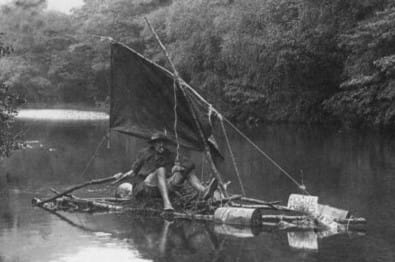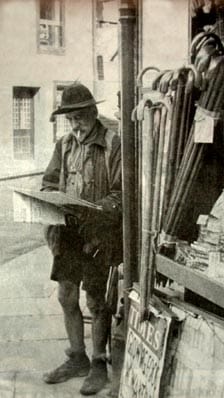Millican Dalton
Millican Dalton, the self-styled “Professor of Adventure” lived in a cave in summer on the side of Castle Crag for nearly 50 years. The cave is located in Borrowdale close to Keswick in the Lake District. Click here to view details of a walking route to the cave.
Born to a Quaker family in 1867, Millican’s family moved south when he was seven, following his father’s death. He enjoyed a typical boyhood of adventure and escapades before facing the sober reality of adult employment. As a young man, he started work in London as an insurance clerk. At the age of thirty-six a keen cyclist, camper and climber, he felt constrained by humdrum work life and, in a radical act for his times, opted to strike out on a simpler life of self-sufficiency long before downsizing and radical life transitions became the norm.
First, he built a forest hut in Buckinghamshire where he lived during the winter months, alternating it with camping in the Lake District during the summer. Next he adopted the title of “Professor of Adventure” and began offering adventure trips in the Lake District to interested campers and lovers of the outdoors.
In the 1920's he moved into a disused splitlevel quarried cave in Borrowdale. Living a frugal life amidst the Lakes he baked his own bread, manufactured his own clothes with a sewing machine, and followed a healthy natural diet.He manufactured pioneering light-weight camping gear, and continued to lead interested groups on adventurous escapes. Millican was known locally for his eccentric outfits, Tyrolean hat and love of dark coffee and Woodbines cigarettes. However, unlike some eccentrics, he was no recluse. Addressed as “the Skipper”, he would lead parties in “mountain rapid shooting, rafting, hair’s-breadth escapes”, and climbing. He also ventured further afield, leading guided mountaineering trips in the Swiss Alps.
A socially engaged man, he delighted in campfire conversations and was always ready to pitch in an opinion on the great ideas of the day. A lifelong bachelor, he also enjoyed deep friendships with women, and offered camping excursions for young women long before they became socially acceptable. The perfect gentleman, he taught rock-climbing to his female charges, even allowing them to lead when their climbing skills permitted. Visitors often spoke of the sense of peace and relaxation that they felt after spending time with Millican. Embracing relative solitude in his cave, he became ever more attuned to nature. In an interview with a newspaper in 1941 at seventy three, he commented, “Well, I don’t sleep much, and while I am awake I lie and listen and think. There’s a lot to think about just now, isn’t there? All the sounds of the nights, the roar of the mountain stream, the barking of our dogs and foxes, the cries of birds, how can I be lonely with such company?”Until the very end of his life, he remained wedded to the outdoors, only moving into a hut during cold winters.
He died aged seventy nine in a hospital ward in 1947, suffering from heart failure and bronchitis. A book lay uncompleted by his bedside. Titled “Philosophy of Life”, it was his journal of observations based on thirty years living in the wilderness. Sadly, the book remains lost to this day. Today Millican’s cave remains a site of pilgrimage. For all lovers of adventure, chivalry, and wisdom, it offers proof that behaving like a gentleman and following one’s personal star can create a signature life that can richly benefit others. Millican never forgot that a man’s true spirit is forged in the crucible of adventure. Every pursuit with one of his groups would be turned into a romantic escapade.


